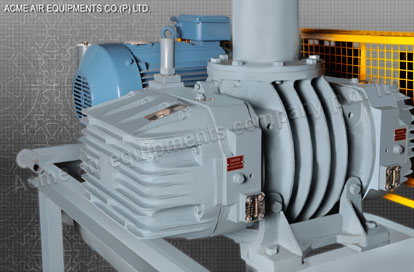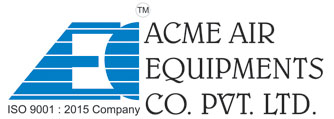Table of Contents
Twin lobe roots blowers are essential positive displacement machines widely utilized in various industries for applications that demand constant airflow or pressure. Renowned for their robust construction, efficiency, and reliability, these blowers are pivotal in industries such as wastewater treatment, pneumatic conveying, chemical processing, and power generation. Their growing global demand stems from industries seeking energy-efficient and sustainable solutions, particularly in regions like the USA, Canada, Europe, Africa, and the Middle East.
This article delves into the working principle of twin lobe roots blowers, their key features, components, global applications, and the factors contributing to their rising demand across international markets.
What is a Twin Lobe Roots Blower?
A twin lobe roots blower is a mechanical device that operates on the positive displacement principle to transport air or gas. It consists of two interlocking, precision-machined lobes that rotate within a sealed casing. These machines are highly versatile, offering consistent airflow and pressure without the need for internal lubrication.
Key attributes of twin lobe roots blowers include:
- Steady Airflow: Delivers pulse-free airflow ideal for critical applications.
- Durability: Designed for long-term operation under demanding conditions.
- Contamination-Free Operation: Suitable for sensitive processes in food, pharmaceuticals, and chemical industries.

Working Principle of Twin Lobe Roots Blowers
The twin lobe roots blower operates on the rotary displacement principle, ensuring a smooth and efficient process for air or gas transfer.
- Inlet Phase:
- Trapping and Transportation:
- Compression Phase:
- Discharge Phase:
As the lobes rotate, they create a vacuum at the inlet, drawing in air or gas from the external environment.
The chute directs the material from the bag into the processing system, while the hopper collects and distributes the material further downstream.
To ensure that no dust escapes during unloading, most systems include a dust control enclosure, ensuring clean and safe operations.
These devices help break up any compacted material in the bag and encourage smooth flow into the hopper.
This straightforward yet highly effective mechanism ensures the blower operates without requiring internal lubrication, maintaining clean and efficient performance.
Key Features of Twin Lobe Roots Blowers
Twin lobe roots blowers stand out due to their advanced design and operational capabilities. Some of their most significant features include:
- Non-Contact Operation: Lobes do not touch each other or the casing, reducing wear and tear.
- Energy Efficiency: Minimal power consumption, even during continuous operation.
- Versatility: Capable of handling different gases across diverse applications.
- Noise Reduction: Equipped with silencers to minimize operational noise.
- Durability: Built with high-quality materials to withstand challenging industrial environments.
Components of Twin Lobe Roots Blowers
The efficiency of a twin lobe roots blower stems from its well-engineered components:
- Lobes: Rotating components responsible for trapping and displacing air or gas.
- Casing: TSealed chamber that houses the lobes and ensures smooth operation.
- Bearings: Support the lobes and ensure precision alignment.
- Drive Mechanism: Typically powered by an electric motor through belts or direct coupling.
- Seals: Prevent leakage of air or gas, ensuring operational efficiency.
Applications of Twin Lobe Roots Blowers
Twin lobe roots blowers find applications in numerous industries due to their ability to provide consistent airflow and pressure. Key industries utilizing these blowers include:
- Wastewater Treatment: Aeration systems rely on these blowers to supply oxygen for biological treatment processes.
- Pneumatic Conveying: Used for the transportation of bulk materials such as grains, powders, and chemicals.
- Power Generation: Supports combustion processes and cooling systems.
- Chemical Processing: Facilitates the handling of gases in controlled environments.
- Food and Beverage: Plays a role in vacuum packaging and material handling.
Global Demand for Twin Lobe Roots Blowers
The demand for twin lobe roots blowers has been steadily increasing worldwide, driven by industrial growth and the need for energy-efficient technologies.
- USA and Canada:
- Industrial sectors such as oil and gas, food processing, and chemical manufacturing are prominent users.
- A focus on reducing operational costs has spurred interest in energy-efficient twin lobe blowers.
- Europe:
- Stringent environmental regulations are promoting the adoption of sustainable technologies.
- Wastewater treatment plants and renewable energy projects significantly drive the demand for twin lobe air blowers.
- Africa:
- Rapid industrialization in regions like South Africa and Nigeria has created a demand for robust and reliable equipment.
- Industries such as mining and power generation heavily rely on twin lobe blowers.
- Middle East:
- The oil and gas industry, a major economic driver in the region, relies on these blowers for gas handling and compression.
- Growing infrastructure projects are further boosting the demand.
How to Choose the Right Twin Lobe Roots Blower
When selecting a twin lobe roots blower, several factors should be considered to ensure optimal performance:
- Application Requirements: Match the blower’s capacity and specifications to your operational needs.
- Efficiency: Opt for energy-efficient models to reduce long-term operational costs.
- Reliability: Choose blowers from reputed manufacturers offering high-quality materials and precision engineering.
- After-Sales Support: Ensure the supplier provides maintenance services and spare parts.
Leading Manufacturers and Exporters
Several manufacturers specialize in producing high-quality twin lobe roots blowers tailored to specific industrial requirements. Companies exporting these blowers focus on delivering reliable and energy-efficient solutions to global markets.
Future Trends in Twin Lobe Roots Blowers
The future of twin lobe roots blowers lies in advancing technology and growing industrial needs:
- Smart Blowers: Equipped with IoT-enabled monitoring systems for predictive maintenance.
- Energy Optimization: New designs aimed at further reducing energy consumption.
- Custom Solutions: Tailored blowers for niche applications in emerging industries.
Conclusion
Twin lobe roots blowers are indispensable for industries requiring reliable and efficient air or gas transfer solutions. Their robust construction, energy efficiency, and versatility make them a preferred choice across diverse applications. With rising demand in regions like the USA, Europe, Africa, and the Middle East, these blowers are set to play an even more critical role in industrial processes worldwide.
FAQs About Twin Lobe Roots Blower
They are commonly used in wastewater treatment, pneumatic conveying, and chemical processing applications.
Their design minimizes energy consumption while delivering consistent performance.
Consider application needs, capacity, efficiency, and support from the manufacturer.
The USA, Canada, Europe, Africa, and the Middle East are key markets.
Yes, their contamination-free operation makes them ideal for food, pharmaceutical, and chemical industries.
About Author

CEO
Mr. Vishwesh Pardeshi is the CEO of Acme Air Equipments Company Pvt. Ltd., an industrial and engineering goods manufacturing company based in Ahmedabad, Gujarat (India). He has taken over the responsibility from founding Partners and Directors of the Company, and is now leading a talented group of professionals since 2020 by bringing in vast industrial and management expertise. By qualification, he holds a Bachelor Degree in Mechanical Engineering and also holds a MBA degree from reputed institutes. Under his leadership, the Company has successfully executed prestigious projects by delivering high quality and world class products from a state of the art manufacturing facility which combines CNC-enabled precision manufacturing and strong after sales support. In line with the Vision, Mission and Core Values of the Organization, Mr. Vishwesh Pardeshi continues to drive Quality, Reliability and Global Expansion at Acme Air Equipments Co. Pvt. Ltd.








